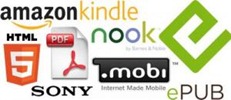 How can publishers create graphical e-books without a lot of duplicated effort? That’s the question posed by Richard Stephenson on FutureBook in a post about the different approaches taken by Amazon, Barnes & Noble, and Apple for displaying fixed-layout graphical content on their e-readers:
How can publishers create graphical e-books without a lot of duplicated effort? That’s the question posed by Richard Stephenson on FutureBook in a post about the different approaches taken by Amazon, Barnes & Noble, and Apple for displaying fixed-layout graphical content on their e-readers:
Amazon’s Kindle format 8 (KF8) relies on a completely separate process to create a fixed layout e-book than Apple’s version of fixed layout for titles that are design-led e-books. Both are based on XHTML, but there are important differences in how pages are laid out. With KF8, each page has to be specified as either portrait or landscape by the creator of the book, and one double page spread that you view in a fixed layout e-book on the Kindle Fire is one XHTML file. In iBooks fixed layout e-books, each of the two pages in a double page spread is a separate XHTML file, and individual pages can be rendered in both orientations. There are also various other notable technical limitations in the current version of KF8 for the Fire. You cannot currently play audio or video with KF8 e-books on the Kindle Fire, although you can do this on Kindle e-books within Kindle apps on the iPad and there is no support for read-along e-books. Finally, there is no pinch and zoom on a page. Instead, KF8 has a feature called ‘region magnification’ which allows the text to pop up when tapped to aid reading. There are advantages and disadvantages to each approach, but the feature is a further move away from a single standard.
Kobo follows similar specs to Apple, but doesn’t support embedded video. Barnes & Noble has developed its own separate tools for creating graphical content for Nooks so the actual format is “a bit of an enigma.”
These different formats pose a problem for publishers who want to create graphical and multimedia works such as picture books or children’s books—they could end up having to create the same book three or four different ways for three or four different platforms. That’s a lot of extra work.
I would add that even ordinary text e-books for which formats have been more or less standardized have their balkanization problems. The different DRM used by each provider, for one thing, and Amazon’s Mobi versus Apple’s and B&N’s EPUB formats for another. And the vested interest these e-book stores have in locking customers into their store only isn’t helping.































I can see an upside to making it hard to create fixed-layout ebooks: there’ll be fewer of them. There are indeed a few books that need a fixed layout even in electronic form, but they’re a tiny, tiny minority. But if it were easy to create them, they’d be everywhere, even for the latest throw-away mystery novels. (I mean, check out the appalling majority of books in Quebec ebook-stores that are *still* available only in PDF format even after two years of operation.)
This comes partly from book designers’ laziness (“I just finished the PDF, I don’t want to have to fiddle with Epub too”) and partly from their hubris (“Everybody should be forced to experience the sheer genius of my design vision, even if it’s illegible on their iPhones”). As it is now, when they actually have to *work* to make a fixed layout that can be viewed on a Kindle, maybe they’ll use it only for the books that really, really deserve it.
“There are indeed a few books that need a fixed layout even in electronic form, but they’re a tiny, tiny minority. ”
Can you show us some statistics on this? Because I don’t see it in reality. I have a lot of books on my shelf that would benefit from a more controlled layout, in a functional way. Fixed layout is not just about eye candy, in many situations there is good reasons to use it.
Kevin – I agree wholeheartedly. This is a lot about very little and basically adds up to just another excuse Publishers jump on to moan and bitch about their plight.
Our starting idea was to end hand-coding while creating fixed-layout EPUBs, maximize layout-quality and deliver the simplest possible XHTML that is human readable and editable for enhancement…
We have been building our own internal conversion framework since Apple implemented their fixed layout feature in iBooks. And we have been successfully using it to produce high precision fixed layout eBooks for our customers. Now we developed a web-based converter which is able to convert from PDF to fixed-layout EPUB (and KF8, too) within minutes and with a astonishing layout-precision. You are welcome to test the converter. We are now in public beta. Register, read our manual how to prepare your PDFs and convert some demos for free at:
http://beta.magicepub.com